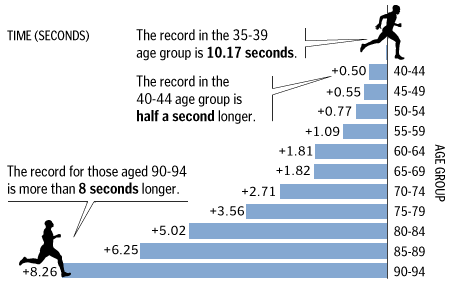Washington Post tweaked for snubbing masters track
Washington Post health writer David Brown has a great report today on how the body slows and weakens with aging. And a graphic (see below) even cites as a source Martin Gasselsberger’s mastersathletics.net rankings and records site. David says in the article: “Conclusion: No part of your body is spared the effects of age. So exercise it all.” But regular Post reader Bob Weiner, the media chair for USATF Masters Track & Field, wasn’t happy that masters rowing and swimming got all the ink. He sent a letter to the Post (which he CC’d to me).
Bob wrote:
David Brown’s excellent report today (“Pulling Against Time”, Washington Post, Feb. 13, 2007) on the physiological elements of age in exercise neglects the need for continuing psychological incentives past the peak ages of efficiency, which he points out are in the late 20’s. That’s why not only masters swimming but masters track and many other sports have ongoing five year age brackets.
Brown is right that continuing exercise maintains the best possible cardiovascular efficiency and extends life spans. Thousands of competitors take part in the national championship masters track meets, open to all comers.
Most major marathons now have more competitors over 40 than under 40. Runners, jumpers, and throwers look forward to the next birthday which puts them into the beginning of a new age group, a never-ending cycle which maintains the incentive to compete, exercise, and stay fit for a (longer) lifetime.
Masters track has competitors in brackets from 30 to 100+ years old! In other words, age never does have to “catch up” with you!
Sincerely,
Robert S. Weiner
USA Track and Field National Masters Media Chair
Accokeek, MD
Here’s the graphic that went with the article (which originally carried as a source “MastersAthletics”:

|





2 Responses
FR: David E. Ortman (M53) Seattle, WA
Assuming the above chart tracks the 100m, when I was 40 I ran 11.79. When I was 52 I ran 12.19. That’s a drop of 0.4 seconds rather than the 0.77 dropoff given above. The key, apparently, to continued success is to beat the chart.
Dave, I don’t think you can “beat” the chart. It may look like you did but at age 40 was your 11.79 as fast as you could have run if you had trained to your limit and run as fast as you could? I think not. You seemed to age less between 40 and 52 because you could have run faster when you were 40. This happens with distance runners all the time. They never ran before. At age 40 with 6 months of running they run a 50 minute 10K. The next year with another year of distance running behind them they run the 10K in 46 minutes. This goes on for the next 2 or 3 years and they think they are getting better with age. They aren’t. They are just getting in better shape. If they had trained between 35 and 40 maybe they would have run a 36 minute 10K. The same thing can happen with the sprints. If you ran 12.19 at 52 you probably had the ability to run the 100 in 11 seconds flat. You didn’t run that time because you weren’t in good enough shape because you hadn’t trained enough.
Leave a Reply